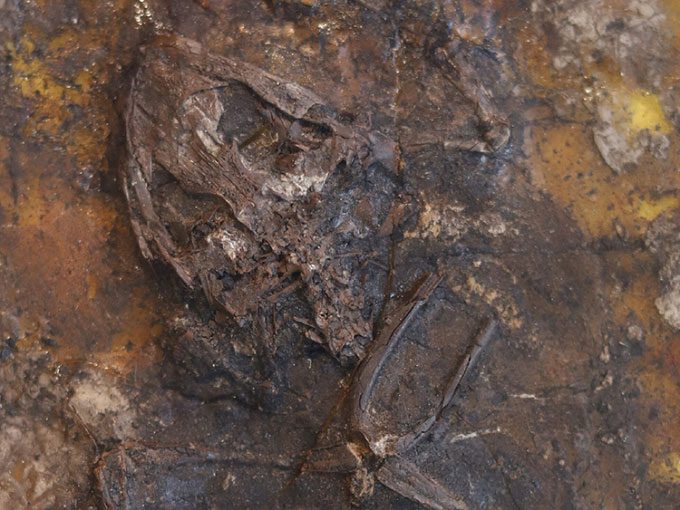An Ancient Swamp in Germany May Have Functioned as a Death Trap, Drowning Hundreds of Frogs During Breeding Season.
The 45-million-year-old fossils of hundreds of frogs that died in an ancient swamp in what is now Geiseltal, central Germany, have long puzzled scientists. The mystery surrounding the cause of their death may now be explained by a new study published in the journal Papers in Paleontology on July 5 by a team of Irish scientists.

Fossilized frogs in Geiseltal, Germany, likely died while mating in an ancient swamp. (Photo: Daniel Falk)
Geiseltal was once a subtropical forest swamp and is one of the richest fossil sites in the world, preserving traces of over 50,000 birds, horses, bats, fish, and frogs. According to the research team, the swamp containing hundreds of ancient frog remains may have acted as a “deadly mating trap” that led to their demise.
“The fossilized frogs were healthy prior to their death. Their bones show no signs of predation or scavenging. There is also no evidence they were swept away by floodwaters or died due to the swamp drying up,” said paleontologist Daniel Falk from University College Cork, a co-author of the study.
“By process of elimination, the only reasonable explanation is that the frogs died while mating,” he concluded. The research team noted that the fossilized frogs belong to the Spadefoot toad family (Pelobatidae). This group of amphibians lives on land, returning to water only for breeding during the mating season.
When modern frogs mate, it is common for one or more males to press the female down into the water, causing her to drown. “This often occurs in species that engage in ‘concentrated mating’ during a short breeding season,” explained paleontologist Maria McNamara from University College Cork, another co-author of the study.
The ancient frogs in Geiseltal exhibited similar mating behavior. This likely caused their bodies to sink to the bottom, where they were carried deeper into the swamp by currents. Over time, the frog remains were naturally buried under clay and sand, eventually becoming fossils.
Frogs can die from freezing, disease, or old age, but these causes of death are challenging to verify. However, after months of studying the discovered fossils, the research team arrived at this astonishing conclusion. The most plausible explanation for why several groups of frogs, numbering in the hundreds, died almost simultaneously in different ponds is due to their overzealous mating activities.
Although these mating-related deaths may seem extreme, a much more common cause of mortality in frogs and toads is human activities, such as habitat destruction, water pollution, and the spread of disease.
Frogs and toads have survived various climate changes and extinction events throughout Earth’s history. However, some species have gone extinct, and others are at risk. Frogs can migrate short distances if environmental conditions in their ponds change. Yet, they are susceptible to diseases, possibly due to human impacts on nature.
The research team hopes this new discovery will contribute to the knowledge of the evolutionary history of toads over millions of years. “Interestingly, fossilized frogs from other sites also exhibit these traits, indicating that the mating behaviors of modern frogs have existed for a long time, at least for 45 million years,” McNamara added.


















































